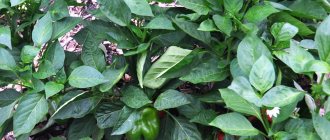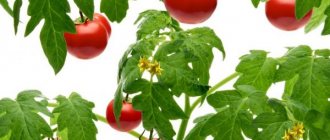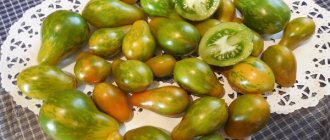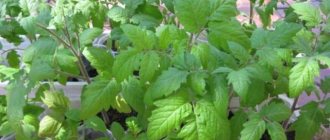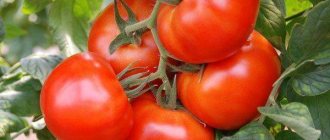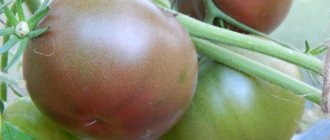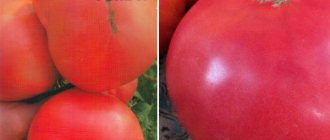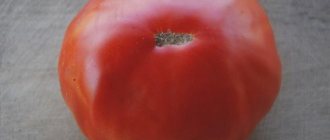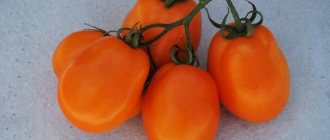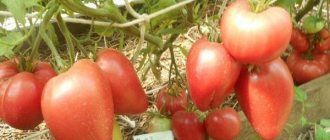Description and characteristics of the Moravian miracle tomato, reviews, photos
The second name for the tomato is Stupike .
An early ripening , productive, unpretentious tomato variety. In 1997, it was included in the State Register for the Central Region for cultivation in open ground.
Bush of indeterminate type, weakly branched and medium leafy, 1.4-1.8 meters high (according to the State Register). Most gardeners indicate a plant height of 60-70 cm, rarely up to 1 meter. Potato-type leaf, medium size, green. The inflorescence of this tomato is complex. The first inflorescence is laid above the 6-7th leaf, the subsequent ones - every 3 leaves.
Basic qualities of fruits
photo by Valentina Redko
The fruits are round, medium density, smooth, red in color at maturity, weighing 60-80 grams , juicy, good tomato taste. These tomatoes are suitable for fresh consumption, pickling, canning, and home cooking.
The yield is high, there is just a wall of fruit on the bush.
The variety is resistant to blossom end rot, cladosporiosis, and late blight.
Value of the variety : super-yielding, early ripening, high taste of fruits and their suitability for canning.
Large harvest with minimal care - Moravian miracle tomato: detailed description of the variety
The Moravian miracle tomato has been present in the gardens of our country for quite some time and does not lose popularity, because its excellent characteristics make us return to it every year. It is undemanding, grows well in open ground and bears fruit abundantly.
| Height | Landing location | Ripening time | Fruit color | Fruit size | Origin | Fruit shape |
| Medium height | Open ground | Early ripening | Reds | Average | Variety | Round |
The Moravian Miracle tomato was created in the nineties and entered into the State Register in 1997. Recommended for cultivation in open ground in the Central region of the Russian Federation.
Bushes of the indeterminate type are considered tall, nominally reaching 140-180 cm. However, in practice the plants turn out to be much lower - from 60 cm to a meter. The leaves resemble potato leaves and are medium in size. The inflorescence is complex. The bush produces its first cluster after 6-7 leaves, new ones develop at intervals of 3 leaves.
At least 90 days pass between seed germination and the first harvest. The fruits are collected in large clusters, which can contain up to 30 pieces. The weight of one tomato is 60-80 g.
Description of pom: round, bright red, with smooth skin. There are 4 chambers inside. The pulp is sweet and sour, aromatic and tasty. They are used for canning and pickling, fresh consumption, use in any dishes and preparation of tomato products.
abundant fruiting;
Minuses:
- There are practically no disadvantages.
In the Central region and further south, the variety can be planted in open ground, and in colder regions a greenhouse is recommended. It is necessary to tie the bushes to a support. Also, garters require separate brushes, as they can break under the weight of the crop.
It is better to pintle, leaving 3 stems.
The fruits are stored for quite a long time and are well transported.
Sowing of seeds begins 60 days before transferring to a permanent bed. First, they are treated for disinfection - soaked in hydrogen peroxide, a three percent solution of potassium permanganate or aloe juice. Then they are washed with water and left for a short time in the growth stimulator solution.
Planted in nutritious soil, which includes garden soil, coarse sand, a little humus or peat, wood ash and superphosphate. The seeds are buried 1-1.5 cm and watered. The recommended temperature of the soil and room where the containers are kept until germination is 25 degrees. A week later the first shoots appear. After this, the temperature is set to 18.
When the seedlings have 2-3 leaves, pick them.
2 weeks before the seedlings are transferred to the garden, they are hardened off by exposing them outside during the day for 30 minutes and gradually increasing the period.
For 1 sq. m. 3-4 plants are placed according to a 40 by 50 cm pattern.
Watering is prescribed weekly, but not excessive. Tomatoes are fed (the first time - 10-14 days after planting), weeds are weeded, preventive treatments are carried out against diseases and insects, and leaves are removed that interfere with the development of fruits.
source
| Size | |
| Productivity | |
| Ripening period | |
| Soil type | |
| Growing method | |
| Purpose of fruits | |
| Disease resistance | |
| Soil ph requirements |
|
| Life form | |
| Shape of fruits/stems/roots and tubers/heads | |
| Size of fruits/stems/roots and tubers/heads | |
| Cultivation region by origin | |
| Vitamin content | |
| Color of fruits/roots and tubers |
Tomatoes Moravian miracle, video
If you grew Moravian Miracle tomatoes, please write whether you liked them or not. What was the yield and taste of the fruits like under your climatic conditions? Will you grow them again? If possible, attach to the comment a photo of the entire bush as a whole or individual fruits that you grew. Thank you!
Your reviews of the Moravian Miracle tomato and additions to the description will help many gardeners evaluate this variety and decide whether it is worth planting or not.
You can see other interesting varieties and hybrids of tomatoes with photos, descriptions and reviews in our Tomato Catalog. Enjoy watching.
Characteristics of the variety
An early ripening indeterminate variety for growing in beds, greenhouses and balconies. Tomato ripening occurs 90 days after planting the seeds for seedlings. The plant is tall, reaching a length of 170 centimeters in maturity. Description of the leaves - similar to potato leaves, medium foliage. The bush requires constant garter. When grown in 3 stems, it bears fruit perfectly, the plant is simply strewn with beautiful small fruits. It is demanding when it comes to forming a bush, so when caring for it you need to pluck off excess shoots and leaves for better fruiting.
The fruits are round, bright red, and when ripe there is no green spot near the stalk. One ovary produces up to 30 tomatoes; the more fruits, the less they weigh. The weight of the tomato reaches 50 grams. The taste of tomatoes is sweetish with sourness, juicy, the flesh is dense. Has 4 seed nests.
The variety is resistant to popular diseases and tolerates minor temperature fluctuations during seed hardening. It is used universally, as it is small in size and has excellent taste.
Characteristics of tomatoes of the Miracle variety
Miracle tomatoes are a whole group of varieties; There are about 30 different subspecies on sale. All this diversity definitely has one thing in common: each variety is designed to surprise you with shape, yield, color or taste. It is thanks to their expressive qualities that this group of varieties got its name.
Characteristics of tomatoes of the Miracle variety
Varieties of Miracle varieties
The first thing the description of this crop says is the fact that the Miracle tomato family includes several varieties. And each of which has its own special characteristics:
Podsiny
Tomato Podsinsky miracle is a mid-season variety of unlimited growth. Its fruits are large, weighing up to 300 grams, with a plum-like shape. The pulp is fleshy and juicy with a small amount of seeds, good for salads, juices and especially sauces. To maintain high yields, grow the variety in a greenhouse and form the bush into two stems. During the season, you can harvest up to 5 kilograms of tomatoes from a plant. The Podsinsky miracle is suitable for growing in the regions of Siberia, Altai, and other areas with an unfavorable climate.
North
Severnoe is an early ripening variety; the harvest is harvested just 100–110 days after the first shoots. Fruits abundantly, forming 4–5 pear-shaped tomatoes in a cluster and weighing up to 100 grams. The consistency of the fruit is fleshy and dense, excellent for preservation. Suitable for outdoor and greenhouse cultivation. It feels great in harsh areas and grows remarkably in the Altai and Transbaikal regions of Russia.
Holland
The miracle of Holland is a tall crop that can stretch up to 1.8 meters. Resistant to diseases, ripening speed is average. The fruits are pink in color, grow on clusters in large numbers, each can gain weight up to 80 grams. Their skin is thick, and the flesh is tender and juicy; they look like they are cut like one: very marketable.
Vnukova
Miracle Vnukova is a very productive tomato, from the Ukrainian originator Svetlana Vnukova. Maturation is average, suitable for cultivation in temperate regions. Requires staking, as it grows up to 2 meters, forms 5–7 fruits in a cluster weighing up to 250 grams. Their color is red-orange, the surface is shiny, the taste is sweet and pleasant. Good for canning and salads.
Striped
Striped, better known abroad as Marvel Stripe, was bred many years ago in the gardens of Mexican Indians. The variety is of medium maturity and growth, 1.2 meters high. It has good disease resistance, but is usually grown in a greenhouse.
The fruits are great for making salads
The shape of the fruit is round-flat, orange in color, with golden rays. Their dimensions are considerable; one tomato can weigh up to 700 grams. In the cross section you can see the yellow branching of the chambers with pink veins, the flesh is steak-like, the taste is very sweet. Best suited for salads.
Moravian
The Moravian Miracle variety ripens early, 50–52 days after transplanting the seedlings. The size of the bush is average, 1.3 meters, but the harvest from it is abundant. The fruits grow like cherry tomatoes, in clusters of 7–8 pieces, each weighing 60–70 grams. Round and even, dense to the touch, the color is evenly distributed, and their taste is pleasantly rich.
These varieties are popular in Argentine cuisine and are also ideal for whole canning and pickling. During cultivation, it is resistant to blossom end rot, late blight and cladosporiosis. Due to this, and good resistance to cold, it is often used as a donor in breeding at botanical gardens.
Iranian
Iranian miracle is a tall crop with a late ripening period, reaching two meters in height and forming 2-3 stems. The weight of the fruit is 350–500 grams, and in rare cases, like Bulgarian ones, up to 1 kilogram. On average, the total yield of one plant is 5.5 kilograms.
Tomatoes are round in shape, flattened on top. When ripe, they become raspberry-colored, with an expressive and sweet taste. Their pulp is dense and will perform well in salads and juices, but is not suitable for salting.
Sweet
The mid-season tomato Miracle Sweet grows in a large bush, up to 1.8 meters. It is tied to a support and formed into two stems, but if you want to grow giants, then form it into one. This is a greenhouse variety and it can only reveal itself under cover.
The fruits of the Miracle Sweet variety are heart-shaped with a ribbed surface and reach 400–800 grams when ripe. The texture is fleshy, with a small amount of seeds, the taste is very sweet, almost like sugar. Do not crack, good for juices and sauces.
Wolford
Bred by Max Walford in the 1980s, the Wolford's Miracle variety has spread well and is loved by many gardeners. The ripening speed of this tomato is average and, depending on the conditions, the bush is formed into 1–3 stems. The better they are, the fewer shoots you can leave.
Loves sunny places and nutritious soil, prefers a mild climate. Forms 4–6 ovaries in the racemes. From which grow medium-sized fruits, weighing 200–300 grams, with a beautiful heart-shaped shape and rich pulp. Designed for salads, sauces and juices.
Chocolate
Miracle Chocolate is a medium-sized variety, up to 150 centimeters in height, not limited in height. Feels good in greenhouses and open ground. It has a powerful trunk, similar to a small tree, the first cluster with fruits begins to set after the eighth leaf. And then, it is formed through the sheet.
This fruit branch contains 4–5 round-shaped chocolate tomatoes. Their weight reaches 350 grams, and inside each there are four seed chambers. The tomatoes turn brownish-red in color, and their pulp is tasty and very sweet; such a miracle tomato will really surprise your guests.
Growing seeds
Seeds need to be prepared before planting
Most varieties of miracle tomatoes are non-hybrid, this can be understood by the absence of a special mark in the description.
For example, “Katrina f1”, where f1 means that it is a hybrid of one generation and its offspring cannot be raised. Therefore, you can then collect the seeds and propagate them yourself without any problems. Start preparing for sowing seedlings by rejecting low-quality seeds. To do this, make a 4-5% salt solution and soak them for less than 10 minutes. We need to get rid of everyone who has a temper; they are not suitable for us.
Description and characteristics
The variety is an early ripening variety, the fruits ripen on 86-90 days. The bush is tall, with enough light it grows up to 170 cm. The fruits are collected in clusters, the largest ones have up to 30 ovaries at a time. The more fruits on the cluster, the smaller they are. The standard value ranges from 30 to 60 g. Since there are a lot of them on one plant, the yield is 2 - 2.5 kg per bush, subject to the rules of care and feeding.
The variety is often used for decorative purposes, located on inclined trellises. The harvest ripens gradually, so the bushes have an almost rainbow color. The first fruits are already bright red, the middle of the cluster is green to white, and the buds are just opening at the tip.
The plant requires staking and regular pinching. It is most often formed into 3 trunks, and gives a bountiful harvest.
Important:
very resistant to late blight and blossom end rot.
